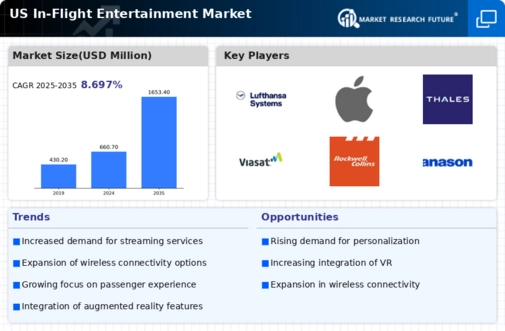The US In-Flight Entertainment Market is characterized by a dynamic competitive landscape, where various players continually innovate and adapt to meet the evolving expectations of travelers. This sector has undergone significant transformation, driven by technological advancements and a growing demand for immersive and personalized entertainment experiences during flights. Key factors influencing competition in this market include the integration of advanced audiovisual systems, in-flight connectivity options, and a diverse library of content available for passengers. As airlines seek to differentiate themselves from competitors, the ability to offer unique entertainment solutions becomes increasingly critical.
Understanding the positioning and strategic initiatives of various companies is essential for gaining insights into the competitive dynamics within this market.Lufthansa Systems stands out in the US In-Flight Entertainment Market by leveraging its longstanding experience and expertise in aviation software solutions tailored for airlines. This company excels in delivering customized entertainment systems that enhance the passenger experience while also promoting operational efficiency for airlines. With a robust presence in the US market, Lufthansa Systems has been able to establish strong partnerships with several leading carriers, enabling them to integrate advanced technologies seamlessly into their existing infrastructures.
The strength of Lufthansa Systems lies in its commitment to continuous innovation, focusing on developing solutions that integrate multimedia content delivery, user-friendly interfaces, and reliable performance, thus ensuring a compelling travel experience for passengers.Apple also holds a notable position in the US In-Flight Entertainment Market, primarily by providing essential technologies and platforms that integrate with entertainment systems used by airlines. With key offerings such as Apple TV, iTunes, and a robust ecosystem of apps, Apple enhances the entertainment options available to passengers during flights.
The company has established substantial market presence through its emphasis on high-quality content and a user-friendly interface that resonates with travelers. Furthermore, Apple’s strength is amplified by its ongoing investments in content partnerships and technology advancements, which contribute to enhanced viewing experiences in-flight. Although Apple does not provide in-flight entertainment systems directly, its devices are widely utilized in airlines’ entertainment strategies. The company has also engaged in strategic partnerships and collaborations that strengthen its foothold, showcasing its commitment to maintaining its relevance in the travel sector while pushing the boundaries of how entertainment is delivered in the skies.



















